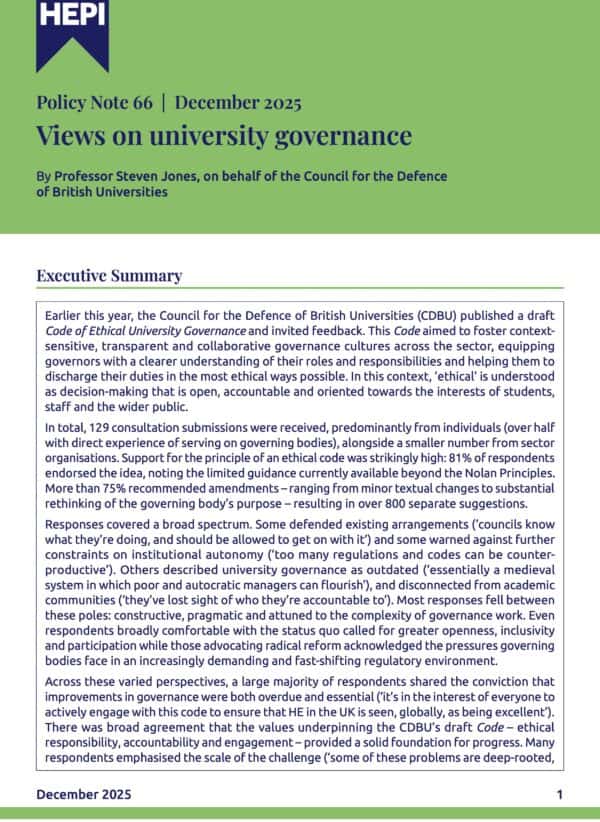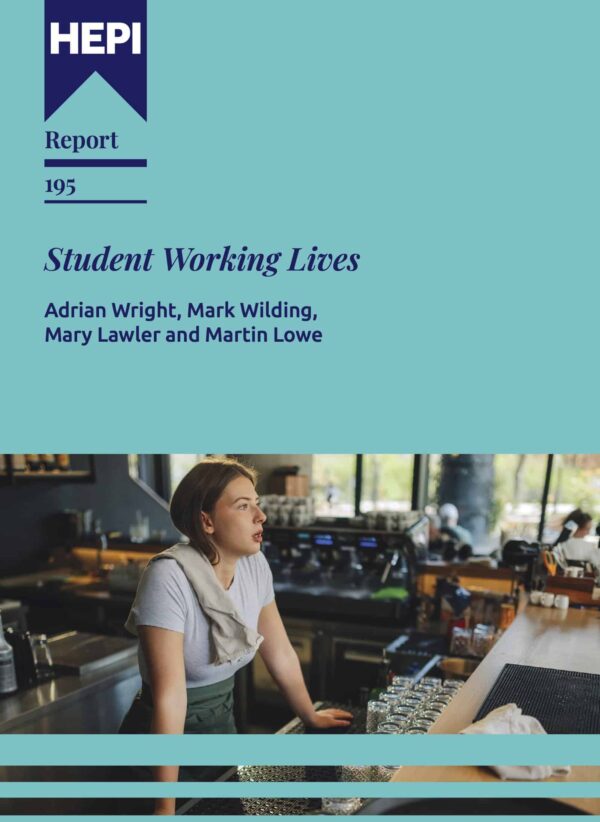UK higher education in spring 2025: 10 ‘killer facts’
This is the text of a speech delivered by Nick Hillman, HEPI’s Director, to the 16th Annual Student Housing Investment Conference.
Good morning. It is wonderful to be here, even if the outlook for our sector does not feel quite as rosy as when I have appeared here in the past – and, given the new migration white paper from the Home Office, not as rosy as it felt just a few hours ago.
The currency of policymaking is ‘killer facts’: those one-off striking statistics that act as ammunition for policymakers.
- One example of a recent killer fact is the Office for Students’ announcement in November 2024 that ‘nearly three quarters (72 per cent) of higher education providers could be in deficit by 2025-26’ (1), which has certainly concentrated minds.
- A second killer fact currently obsessing policymakers is 782,000 (2), which is the number for net inward migration to the UK in 2023 and which is driving the new crackdowns.
In what is left of my 15 minutes, I want to focus on a few more killer facts.
First, just in case you have not come across the organisation I lead before, the Higher Education Policy Institute or HEPI is the UK’s only specialist think tank for higher education and a registered charity. Our goal is to prompt evidence-based conversations about higher education policy through engagement, publications and events. We are funded by most universities throughout the UK and a limited number of corporations, including some of the bigger Purpose-Built Student Accommodation (PBSA) providers, such as Unite Students, UPP and iQ, and we are very grateful for that support.
The killer number I wish to provide about our own work is 10: that is how many new bits of research we have produced since 1 January 2025 (3). The reports we have covered include:
- a study with Kortext of students’ use of generative AI;
- a report I co-authored with Mark Brooks on the underachievement of boys and young men, sponsored by Ulster University; and
- in conjunction with the University of Bristol and Advance HE, a paper on whether students and graduates feel, with the benefit of hindsight, that they made the right decision about their higher education.
We have also published 112 blogs since 1 January, covering the full range of higher education issues. The three most well-read pieces so far this year are:
- a piece on the financial challenges facing the sector by the Vice-Chancellor and Chair of SOAS;
- a moving obituary to the wonderful higher education research Professor Claire Callender by Professor Simon Marginson; and
- the latest take on the Renters’ Rights Bill from Martin Blakey, the recently retired Chief Executive of the student accommodation provider, Unipol.
Conferences like this one are organised far in advance and the title I was given is ‘New Government Policy – what does it mean for the Sector?’ All I can say is: I wish I knew. I suspect the organisers thought we might have found out the answer to this question by now when they first scoped out the agenda late last year.
But the fact is, aside from a letter from the Secretary of State for Education, the Rt Hon. Bridget Phillipson, to vice-chancellors from November last year, which chastised universities for not doing more on economic growth, access, teaching quality, efficiency and civic engagement, we are still waiting for a hint on what this Government’s legacy on higher education will be. So far, we have had more higher education policy from the Home Office and Ministry of Housing, Communities and Local Government than we have from the Department for Education.
I keep reading the administration is in its early days and needs time to find its feet, but it is now 10 months in. It took Tony Blair just two months after the 1997 election to announce the (re)introduction of tuition fees and it took the Coalition just six months after the 2010 election to announce the tripling of fees to £9,000.
We have long ago missed the boat for making significant changes to fees and funding for 2025/26 and we will soon miss the boat for making changes for 2026/27, by which point we will be halfway through this Parliament.
One of the reasons for the lack of clarity over government policy is that the shadow ministers who were responsible for the Labour Party’s approach to higher education and research in Opposition prior to the election did not end up in charge of those areas in government, so there was a new broom. This sort of sweeping out is now entirely normal. Which takes me to my next killer fact: in my 11 years leading HEPI, there have been 11 Ministers for Universities and 11 Secretaries of State for Education (4).
The biggest challenge facing institutions currently is obviously the financial one. Since the brave decision to raise the full-time undergraduate fee cap to £9,000 from 2012, inflation has been eating away at the sum so it is now less than two-thirds of what it was, in real terms: according to Mark Corver of DataHE, the current fee cap of £9,250 is actually worth just £5,714 in 2012/13 terms (5). That is the same level as when John Major felt it necessary to set up the Dearing review, with the agreement of Tony Blair in Opposition.
Mark Corver also points out in his recent fascinating LinkedIn post that an international student at a higher-tariff provider is now worth £69,000 (6) more to their university over the lifetime of a three-year course than a home student, as a result of the much higher international student fees. One possible response to that is to beat up on universities, as the Minister for Universities did earlier this week in a piece on the Telegraph website, for feathering their own nests. Another is to recognise that universities have not let their charitable status hold them back in becoming a vitally important UK export sector from which we all benefit – and also that it is our leading universities’ entrepreneurial spirit which has created the cross-subsidies that keep UK universities at the top of the international league tables, which ministers generally like to celebrate.
And despite all the accusations and denials, we should be honest that university staff would have to be super human not to take those stark numbers into account when deciding how many of their places will be reserved for people from other countries and how many for home students.
When I have spoken at this and similar events in the past, I have usually been optimistic on future student numbers. There are still some grounds for optimism in relation to both home and international students. For example, we have had decades of growth in UK higher education and the number of UK school leavers grows in each year of this decade.
We used to predict that English universities alone would need another 350,000 places for home students by 2035 (7) – and many more still if the opportunity to reach higher education were spread more equally throughout society. However, we are more pessimistic now because, while demand for higher education went up during COVID, it has slipped back in recent times.
In relation to international students, last week’s report from the Office for Students notes:
‘The reported non-UK student recruitment in 2023-24 was 15.5 per cent lower than last year’s forecast, largely because of a reduction in recruitment from January 2024 onwards [when the rules on dependants were tightened up]. This reduction is forecast to continue in 2024-25 with a small overall decrease in student numbers, meaning that entrant numbers are now projected to be 21 per cent lower than previous forecasts.’
Yesterday’s migration white paper was accompanied by a Technical Annex, which estimated the policy changes the Government has proposed will reduce incoming international students by getting on for 40,000.
In relation to home students, the Office for Students’ report notes:
‘In 2023-24, UK entrants were reported at broadly the same level as the previous year, but 10.8 per cent lower than forecast.’
When it comes to the future, the OfS chastise regulated providers for being over-ambitious and model some alternative options, which suggest ‘providers would face significant financial challenges in all scenarios.’
No one knows with complete certainty why demand is now so flat, but – when focusing in on home students – it seems to me the most likely causes are:
- First, the cost-of-living affecting students, whose maintenance packages have not kept up with anything like the true cost of being a student – my killer facts on this are that 57% of full-time undergraduates now do paid work during term time (8) (according to the 2024 HEPI / Advance HE Student Academic Experience Survey) and also that, according to our calculations, students need £18k per year to live with dignity (9), which is significantly above the maximum maintenance loan – this number was calculated for second and third-years in houses of multiple occupation, but I can announced today that we are now working on a second iteration of the Student Minimum Income Standard with Technology1 and the University of Loughborough looking at first-year students in PBSA.
- The second factor that I think is dampening demand is the negative rhetoric about higher education emanating from all sorts of places. In the last few days, we even have had two Labour MPs for northern seats say they are relaxed about the prospect of universities disappearing – one of them, Dan Carden, wrote in the Daily Mail that he ‘would close half our universities and turn them into vocational colleges.’ With friends like that, who needs enemies?
Before I sit down, I want to make just one more point. I was asked in the rubric for today to mention degree apprenticeships. So let me say that there is a whole lot of nonsense talked about them, especially to young people. They are amazing when they work out, such as when the apprentice knows exactly what profession they want to enter and to work in for the foreseeable future. I am proud to have a relative doing one. But despite all the promises, especially from the previous Government, degree apprenticeships barely exist for young people just out of school. Only 5% of Level 6 entrants are on degree apprenticeships (10) and the majority of them are 25 or over – just 13% were aged 18 in 2022/23. Moreover, many of those who do start a Level 6 apprenticeship do not complete the course. So for a conference like this one in 2025, degree apprenticeships remain something of a red herring.







Comments
Add comment